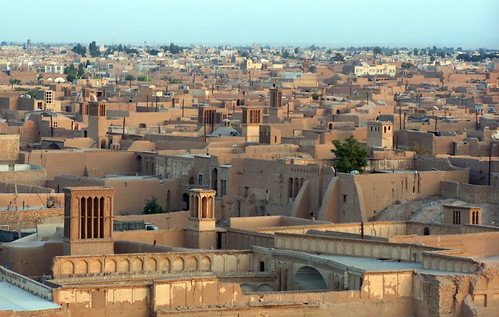PhD dissertation, Technical University of Dortmund, Germany, 2011.
In order to find the possible uses of the traditional urbanism in solving the modern urban problems, some of the contemporary urban problems that were likely to be partly or completely solved were targeted in chapter 1. The two research questions that were going to be answered were 1) which characteristics of the traditional Iranian urbanism can we use to solve some of the modern urban problems of the country? and 2) How can the effective traditional city characteristics be applied to ease some of the modern problems? Before studying the Iranian cities, the similar experiences in other countries and cultures were considered. The neo-traditional trends, practices, and built communities were discussed so that the nature of the research is determined. For example it was explained how the compact and traditional urban form was used to control urban sprawl in North America. Apart from the practical background, the theoretical aspects were reviewed. These theoretical bases were the interactions of built environment with urban transportation and environment. Before starting the main body of the research, the previous researches on the traditional urbanism including urban form, the main elements of the Iranian city, and the historical views of the urban growth were discussed. Also some of the neighbourhood infrastructures were described to make the foreign reader familiar with the Middle Eastern urban architecture. The main research methods that were used were direct observation, literature review, and Space Syntax theory. The theoretical bases and applications of SS were explained in chapter 6. Two case study cities were selected to be studied; Yazd and Kashan that both are located in the center of Iran. The studied cities contain a population of 400000 and 270000 so the results are generalized for the cities with the same range of population in similar climates and geographical conditions. Such cities are mostly mid-sized cities or small large cities in the south, east, and center of the country and also some parts of the western provinces. The historical urban growth, population growth, the typology of the constructions in the historical core and the new developments, mobility flows in the new and old textures, neighborhood organization, Neighborhood unit centers, and the hierarchy of the street networks of the two cities were studied. The first research question was answered by defining the main characteristics of the traditional Iranian city. To answer the second question, solutions in form of general strategies were discussed. Each of the suggested strategies can be implemented via some practical ideas. The study was started by the following hypothesis: “There are tips in the traditional Iranian city that have the capability to be used in contemporary Iranian cities to improve the related conditions of urban transportation, environment, energy use, and land consumption”. At the final stage of the work, it became apparent that the hypothesis is true because the possibilities and circumstances of using the traditional specifications and values became clear.
In order to find the possible uses of the traditional urbanism in solving the modern urban problems, some of the contemporary urban problems that were likely to be partly or completely solved were targeted in chapter 1. The two research questions that were going to be answered were 1) which characteristics of the traditional Iranian urbanism can we use to solve some of the modern urban problems of the country? and 2) How can the effective traditional city characteristics be applied to ease some of the modern problems? Before studying the Iranian cities, the similar experiences in other countries and cultures were considered. The neo-traditional trends, practices, and built communities were discussed so that the nature of the research is determined. For example it was explained how the compact and traditional urban form was used to control urban sprawl in North America. Apart from the practical background, the theoretical aspects were reviewed. These theoretical bases were the interactions of built environment with urban transportation and environment. Before starting the main body of the research, the previous researches on the traditional urbanism including urban form, the main elements of the Iranian city, and the historical views of the urban growth were discussed. Also some of the neighbourhood infrastructures were described to make the foreign reader familiar with the Middle Eastern urban architecture. The main research methods that were used were direct observation, literature review, and Space Syntax theory. The theoretical bases and applications of SS were explained in chapter 6. Two case study cities were selected to be studied; Yazd and Kashan that both are located in the center of Iran. The studied cities contain a population of 400000 and 270000 so the results are generalized for the cities with the same range of population in similar climates and geographical conditions. Such cities are mostly mid-sized cities or small large cities in the south, east, and center of the country and also some parts of the western provinces. The historical urban growth, population growth, the typology of the constructions in the historical core and the new developments, mobility flows in the new and old textures, neighborhood organization, Neighborhood unit centers, and the hierarchy of the street networks of the two cities were studied. The first research question was answered by defining the main characteristics of the traditional Iranian city. To answer the second question, solutions in form of general strategies were discussed. Each of the suggested strategies can be implemented via some practical ideas. The study was started by the following hypothesis: “There are tips in the traditional Iranian city that have the capability to be used in contemporary Iranian cities to improve the related conditions of urban transportation, environment, energy use, and land consumption”. At the final stage of the work, it became apparent that the hypothesis is true because the possibilities and circumstances of using the traditional specifications and values became clear.
more about Iranian cities:


No comments:
Post a Comment